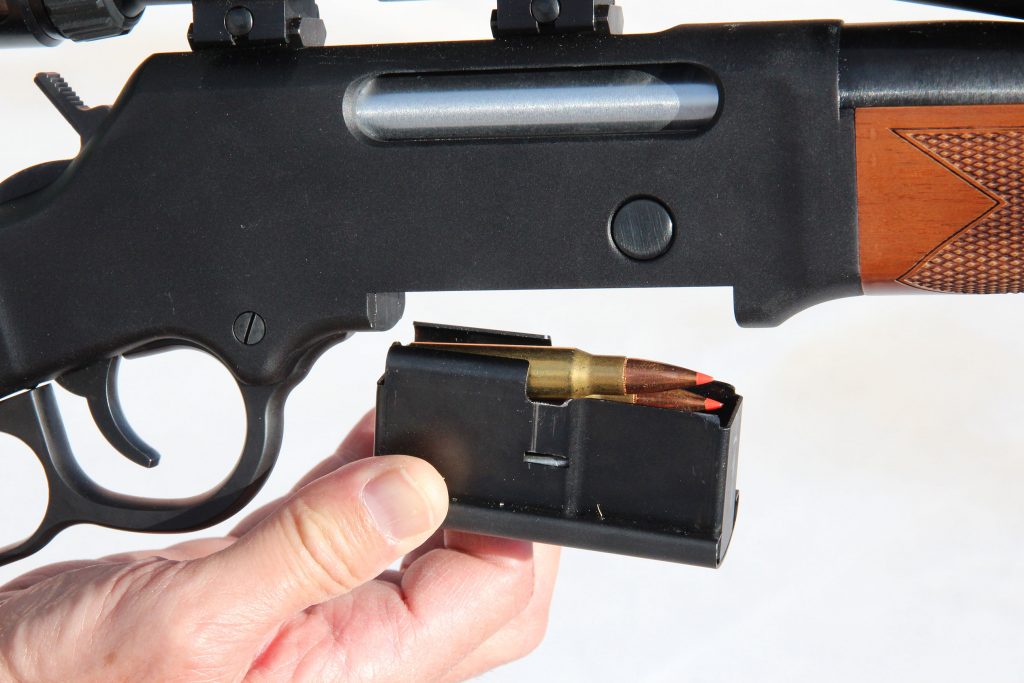Lever-action rifles have traditionally suffered ballistically from things such as the strength of their designs and cartridges for which they’re chambered. But that hasn’t stopped manufacturers from trying to make them better at taking deer over longer distances. From the ammunition perspective, Hornady introduced its LEVERevolution line that uses FTX bullets with soft, rubber-like points. With that construction, loads such as the .30-30 Win. benefit from having higher ballistic coefficients. They shoot flatter and at the same time remain safe to load in tubular magazines where the bullet point of one cartridge may rest against the primer of the next.
Several years back, Marlin teamed with Hornady to combine that same FTX technology with a new .308 Marlin Express cartridge. This gave hunters a flat-shooting cartridge with near .308 Winchester performance from a traditionally styled Marlin lever-action rifle.
Other manufacturers have simply designed their lever-action rifles around pointed bullet cartridges in the first place. They use magazines that don’t line the cartridges up point-to-primer. For example, Winchester’s Model 1895 came chambered for cartridges such as the .30-06 and has a fixed internal box magazine that you top load. Later, Winchester’s Model 88, that takes a detachable box magazine, came chambered for cartridges such as the .284 Win. Savage’s Model 99 uses a rotary magazine, and later models a detachable box, in chamberings including .250 Savage. Browning’s BLR also uses a detachable box and is chambered for such hot-stepping flat-shooters as 7mm Rem. Mag. and .300 WSM.
Last year, Henry Repeating Arms entered the long-range lever gun business by introducing its Long Ranger rifle chambered in .223 Rem., .243 Win. or .308 Win. “Twenty years ago we started with the H001 .22 and have added more and more centerfire calibers for different hunting needs,” says Henry President Anthony Imperato. “We will continue to do that, expand the line and be a one-stop source for anything lever. The lever-action is America’s unique contribution to firearms design. We think that the lever is truly America’s rifle,” he adds.
One of the things I really like about Imperato is that he is unquestionably a true American Patriot. A lot of manufacturers throw “Made in America” around a little recklessly or get around it with phrases such as “Assembled in America.” Not Henry. “Made in America or not made at all” is Henry’s slogan. If you want to see how serious Imperato is about American-made, look up the Henry “Made In America” commercial on YouTube.
Visually and mechanically, the Long Ranger has a lot in common with Browning’s BLR. No slight to the BLR, but I personally think the Long Ranger is a much more attractive rifle. I prefer the Long Ranger’s sleeker lines and satin finish on the American walnut stock as well as its flush magazine release button and blued steel forend cap. “We contemplated an internal hammer and tang safety but struggled with concepts for making high performance while avoiding non-traditional looks,” says Imperato regarding the Long Ranger’s aesthetics.
Both the Long Ranger and BLR use a rack-and-pinion gear system lever with rotating bolt head, but they are different. Most notably, the Henry’s trigger is mounted in the receiver, while the BLR’s is attached to the finger lever and travels with it. “The trigger and fire control mechanism are a unique, obvious improvement and is consistent with Henry centerfire products in that it uses a transfer bar safety and trigger lock,” explains Henry General Manager Andy Wickstrom.
Because of the transfer bar safety, the Long Ranger is safe to carry with the chamber loaded and the hammer down. There is no separate mechanical safety. Simply thumb back the coil spring-powered hammer when ready to shoot. The trigger lock Wickstrom referred to is a small tab at the rear of the trigger that has to be depressed in order for the Long Ranger to fire. It’s depressed by the finger lever as it closes, making it all but impossible to fire the Long Ranger before its action is fully and safely closed.
Another difference is that the Long Ranger’s magazine seats flush with the bottom of the receiver. This makes the barrel is fully free-floating instead of using a forend tip pressure point. The stock has a straight wrist, though Imperato says Henry is evaluating the possibility of introducing a pistol-grip version.
One of the criticisms I’ve seen of the Long Ranger is that while it comes ready for scope mounting, it does not come with iron sights. To me, that’s silly. It’s Henry’s long-range lever-action intended for shots that are 200 yards or more where you want a scope, not iron sights, especially in a hunting situation. If you’re looking for a “brush gun” or intend to shoot 200 yards or less and want iron sights, Henry’s similar lever-action in .30-30 Win. is a no-brainer. That said, the market has spoken and Imperato says iron-sight versions will be on the market soon, maybe by the time you’re reading this.
I recently received a Long Ranger chambered in .308 Winchester and topped it with a Trijicon 3-9x40mm AccuPoint scope for accuracy testing. “Accuracy is good, but it depends a lot on the shooter and the ammo,” advised Imperato. “Federal Fusion seems to be near the top.”
Feeding is very smooth. Instead of a traditional lifter system, like on most lever guns, the Long Ranger strips cartridges from the top of the box magazine just like a bolt-action rifle. Six rotating lugs engage a barrel extension in the last ¼ inch of lever travel providing a level of lock-up equal to many bolt-actions.
The gun shoulders naturally while the generous rubber recoil pad soaks up kick and has enough grip to keep the gun on your shoulder for fast follow-up shots on big, tough bucks. Unlike many lever-actions with stocks originally designed for iron sights that position your head too low to center your eye in a scope, the comb of the Long Ranger was designed from the start to not only look good, but also properly position your eye even when using a solid cheek weld.
Mechanically, the Long Ranger worked great, though ejection seemed a little weak. Cases always cleared the action if the gun was held perfectly upright. But if the top of the gun was canted to the left by any noticeable degree, they were sometimes left loose in the action.
 At 5.8 pounds pull, the trigger was OK. It seemed a little “soft,” but had no creep or overtravel to speak of. “Any gun with a sole intended purpose of long-range shots might have a 2-pound trigger and a 24-inch heavy barrel,” says Imperato, “but I wouldn’t want to walk around the woods with that gun.”
At 5.8 pounds pull, the trigger was OK. It seemed a little “soft,” but had no creep or overtravel to speak of. “Any gun with a sole intended purpose of long-range shots might have a 2-pound trigger and a 24-inch heavy barrel,” says Imperato, “but I wouldn’t want to walk around the woods with that gun.”
Good point — and with a weight of 7 pounds, the Long Ranger is a much better choice to carry afield than a bull-barreled bench rest gun even if the trigger pull is heavier.
Accuracy was excellent — so long as the bore was clean. My first two shots using Hornady 165-grain SST Superformance touched, but the third shot dropped opening the group up to 1.19 inches. The second group stringed vertically more than 2 inches and the third group a little more. In my experience, that kind of vertical stringing is sometimes caused when a bore fouls heavily and quickly. Often I see that with all-copper bullets because they tend to be made from a softer copper alloy and can really lay down copper in the bore. Sometimes a bore is rough and that causes it to foul quickly. Sometimes certain bullets and bores just don’t get along nicely.
I checked to make sure everything on the Long Ranger was tight, and then cleaned the bore. After cleaning, my next group measured a satisfying 0.55 inches. Time didn’t allow a thorough testing of several different loads to further diagnose the stringing so I simply pushed a patch wetted with Hoppe’s Elite Bore Cleaner followed by a dry patch between groups. That light cleaning regimen stabilized accuracy and brought the average 100-yard group size down to 1.46 inches. Normally I don’t put much faith into barrel “break-in,” but it is something to consider here as well as Imperato’s advice about accuracy depending in part on the ammo.
Overall, I think the Long Ranger succeeds in providing whitetail hunters with a rifle who want bolt-action accuracy and chamberings, but in a lever gun. Add to that the greater ballistic ability afforded by shooting pointed bullets and the Long Ranger delivers what its name promises. Currently Henry is contemplating other short-action chamberings that will be announced. A long-action for cartridges such as the .30-06 is being considered, though the timeline for that introduction has not been finalized.
For more information: www.henryrifles.com.








